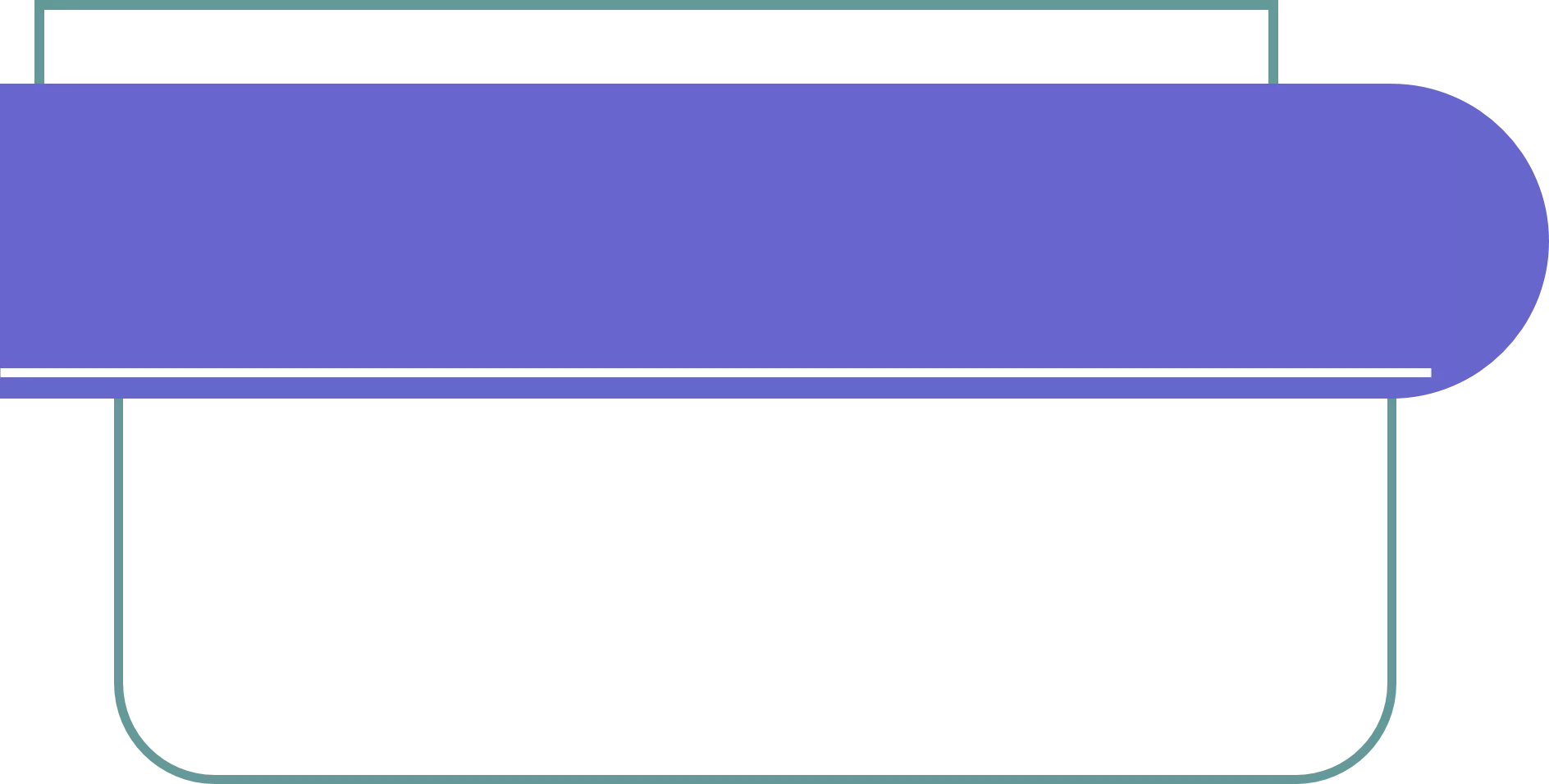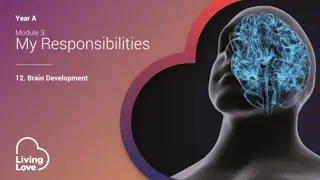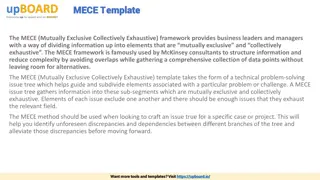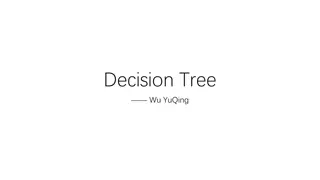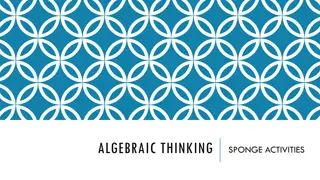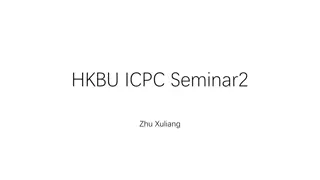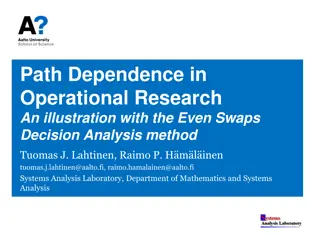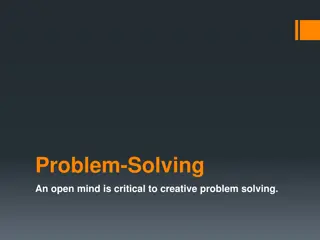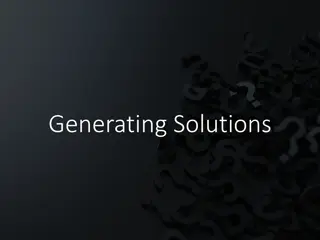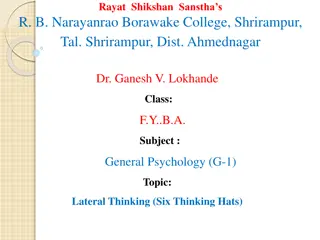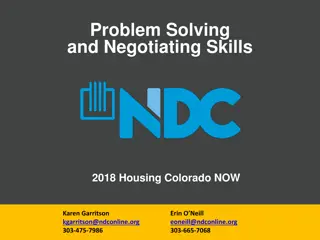Problem Solving and Decision Making Skills Workshop Overview
Workshop on problem-solving and decision-making skills by Dr. Tarak Bahadur KC focuses on defining problems, recognizing reactions, explaining approaches, and identifying practices to improve decision-making ability. The content covers classification of decisions, decision-making processes, practices in Nepal, common problems, and approaches for enhancement through interactive methods like brainstorming and critical incident analysis.
Download Presentation

Please find below an Image/Link to download the presentation.
The content on the website is provided AS IS for your information and personal use only. It may not be sold, licensed, or shared on other websites without obtaining consent from the author.If you encounter any issues during the download, it is possible that the publisher has removed the file from their server.
You are allowed to download the files provided on this website for personal or commercial use, subject to the condition that they are used lawfully. All files are the property of their respective owners.
The content on the website is provided AS IS for your information and personal use only. It may not be sold, licensed, or shared on other websites without obtaining consent from the author.
E N D
Presentation Transcript
Problem Solving and Decision Making Skills -Tarak Bahadur KC, PhD tarakbkc@gmail.com 1
Learning Objectives Define problems and decisions Recognise reactions to problem / situation Explain decision making approaches and process Recognise decision making practices in Nepal Identify decision making problems Explain approaches to improve decision making ability 2
Contents Meaning of Problem Solving and Decision Making Classification of Decisions Reactions to Problem / Situation Process of Decision Making Decision Making in Nepal Problems in Decision Making Approaches to Improve Ability to Make Decisions and Solve Problems 3
Methodology Interactive Lecture Brainstorming Critical Incident 4
Problem In a day, when you don t come across any problems- you can be sure that you are traveling in a wrong path. -Swami Vivekananda A problem is a situation or a state of affairs that causes difficulties for people. It is also a gap between a current and a desired state. The gap may be viewed as the difference between 'what is' and 'what should be' or 'where we are' and 'where we want to be'. 6
Problem Solving If a problem is a gap between two states, then problem solving is 'the process of closing that gap, i.e. changing the current state into the desired one.' 7
Decision A decision is a judgment - Peter Drucker A choice between or among various alternatives 9
Classification of Decisions Personaldecisions to achieve own objectives. Organisationaldecisions to fulfill the obligations of own position in the organisation. - Programmed usually made at lower level and are usually routine in nature. Made on the basis of pre- established rules / procedures. - Non-programmed established rules / procedures are inadequate to deal with the new kinds of situations, and the decision maker has to be innovative. The risks involved are high. Decisions made about non-recurring problems for which there are no pre-specified courses of action. 10
Decision Making ------ is an activity carried out in the process of solving problems. ------ is the selection of one behaviour alternative from two or more possible alternatives. -Terry 11
Reactions to Problem / Situation Ignore or avoid Act without thinking Positively decide to do nothing Take decision only when there is a crisis or pressure Take action only after gathering information and giving some thought 12
Approaches to Decision Making Authoritarian -deciding independently seeking no contributions other than asking for necessary information and passing them down the line for implementation. Democratic -jointly, as a team, making a decision which has the support of the whole group. 13
Approaches / Styles to Decision Making No one style appropriate for all situations. Occasions when one style rather than any other is more likely to produce better quality decisions implemented with greater success. Need to adopt a flexible approach by varying style in response to the nature of the decision and the context in which it is made and ultimately implemented. 14
Process of Decision Making Rational DM Process Evaluate Alternatives Develop Alternatives Choose the Best Alternative Implement the Decision Identify/Define Problems Monitor the Implementation Sense Effects 15
I Diagnose Problem/ Define the Objective "A problem properly defined is a problem half solved. Define the problem Identify the decision objectives (what will happen when the problem has been solved) Identify the causes of problem What you are trying to achieve? What suggests that there is a problem? To who is it a problem? What kind of problem is it (attitude, understanding, competence)? Has this ever happened before? Is it a human performance or a technical problem? What is the potential magnitude of the problem if it remains unresolved? 16
II Develop Alternatives to Solve the Problem This is a brainstorming step to generate alternatives, not to evaluate them. Brainstorming suggests a range of possible solutions. Listing options (Thinking creatively) - the alternatives to reach Pokhara? "no - Nobody says "That will never work - Nobody says "That has already been tried before - Nobody says "That is a stupid idea" - Nobody says 17
III Evaluate Alternatives Realistic to Organisation Goals Helpful to Solve the Problem Timing Resources Acceptability Feasibility Risk 18
IV Choose the Best Alternatives Solution should be satisfactory rather than ideal. There are four criteria for choosing the best from among the possible solutions: 1. The risk - weigh the risks of each course of action against the expected gains. 2. Economy of effort - which will give the greatest results with the least effort? 3. Timing- situation in the organisation. 4. Limitations of resources - vision, competence, skill, etc. of staff who carryout decisions. Do we have resources to carryout decisions? 19
V Implement the Decision Putting a chosen solution into effect requires a carefully drawn-up action plan. SN Activities / Actions By Required Resource (s) Critical Success Factor (s) Whom When 20
VI Monitor the Decision Set dates for monitoring. Who will monitor? How and when? Is the solution effective? Are we still satisfied? Are there parts that need reworking? In light of new data received, do we need to make any changes? Has there been any permanent improvement? How adequate have our problem solving procedures been? Are we learning from experience? What new problems have we identified? 21
Bases of Decision Making (Nepal) Constitution Acts, Rules, Policies Court / Executive order Budgetary instruments Administrative procedures International conventions, declarations and commitments Treaties/ MOUs with international communities / agencies Parliamentary directives CIAA / NVC directions, etc. 22
Methods (Nepal) Tippani Cabinet Proposal Minutes (Meeting / Committee) Tok-aadesh 23
Characteristics / Approaches (Nepal) "Manasaya" "Bholi" - never comes. Passing to others (above) / avoidance Afno manchhe- nepotism, favouritism Patchwork/ 11th hour Ad-hoc Populist Survival (individualistic) Pressure individual / group Centralized- dominated by power centers Delegated matters forwarded to delegatee Ignorance to institutional interest 24
Problems in Decision Making (Contd.) Which problem to solve? What is a right decision? External and internal environment Individual's biasness / prejudice, experience Time Conflicting information For some thinking is not work values, capabilities, 25
Basic Approaches to Improve Decision Making Ability 1. Improve analytical ability 2. Adopt systematic approach 3. Invite conflicting views 4. Consider factors influencing decision making 5. Use imagination / Be creative 6. Implementation and follow-up 26
1. Improve analytical ability Opinions are perfectly good starting point. Ask questions starting with: What, Why, When, How, Where, and Who. 27
2. Adopt systematic approach Analyse the situation Identify possible courses of action Weigh them up Decide what to do 28
3. Invite conflicting views One should not expect a bland consensus view The best decisions emerge from a clash of conflicting points of view 29
4. Consider factors influencing decision making Availability of resources Environment- internal / external (PEST) Capability, values, experience of concerned people Knowledge Time Biasness / prejudice Customs and habits of people Psychological factors- emotion, ethics, values Future as anticipated Superiors and subordinates Interest / Pressure groups 30
5. Use imagination Use 'lateral thinking' and 'brain-storming'. You can develop your ability to think creatively by: Breaking away from any restrictions Opening up your mind to generate new ideas Delaying judgment until you have thoroughly explored the alternative ideas (for example, 'It won't work', 'It won't solve the problem') 31
6. Implementation and follow-up A problem is not solved until the decision is implemented. Think carefully not only about how a thing is to be done (who, what, when) but also about its impact on the people concerned and the extent to which they will co-operate. 32
Some Tips for Effective Decision Making Do not make decisions that are not yours to make It is not choice between right or wrong, rather choosing from among alternatives Avoid snap decisions What is right, not who is right Consider those affected by the decision (involve if feasible) Mentally rehearse implementation of your choice View a problem as an opportunity Decision must meet the situation, and be acceptable to as large number of people as possible Choosing the right alternative at the wrong time is not any better than the wrong alternative at the right time, so make the decision while still have time 33
Conclusion Decision must meet the situation, and be acceptable to as large number of people as possible. Effective decision making requires creativity. Creative thinking is hindered by commitment block, perceptual blocks, emotional blocks and cultural / environmental blocks. Therefore, first thing is to overcome from the blocks and be creative in different course of action, likely causes, possible solutions, and a variety of outcomes. Finally, maintain ethical behaviour and integrity while making decisions. 34
Think Laterally, and be Creative. Good luck and Thank you 35

 undefined
undefined